Volume 41 Number 4
Hand dermatitis among nurses during the COVID-19 pandemic: frequency and factors
Ayla İrem Aydın, Meryem Atak, Nurcan Özyazıcıoğlu Nurcan and Vahit Dalkızan
Keywords nursing, Wound care, handwashing, COVID-19, dermatitis, hygiene
For referencing Aydın Aİ et al. Hand dermatitis among nurses during the COVID-19 pandemic: frequency and factors. WCET® Journal 2021;41(4):10-14
DOI
https://doi.org/10.33235/wcet.41.4.10-14
Submitted 7 December 2020
Accepted 10 February 2021
Abstract
Objective To determine the frequency of hand dermatitis among nurses during the COVID-19 pandemic and factors affecting its prevalence.
Methods The research sample consisted of 175 nurses working in state hospitals. Research data were collected via Google Survey between October and September 2020. The data were collected using a Sociodemographic Data Collection Form, and a self-assessment form was used to determine dermatologic symptoms.
Results The frequency of hand dermatitis among nurses was 70.9%. A statistically significant difference was found between sex, allergy history, and increased frequency of handwashing and the frequency of hand dermatitis. No significant difference in terms of the frequency of hand dermatitis was found between the nurses who provided care to patients who were COVID-19 positive versus the nurses who did not provide care to patients who were COVID-19 negative. However, the frequency of washing hands and using hand disinfectants and hand creams was found to have increased significantly during the COVID-19 pandemic compared to the prepandemic period.
Conclusions The frequency of hand dermatitis increased among nurses during the pandemic. The increased frequency of handwashing during the pandemic poses a risk for hand dermatitis among nurses, although this should not discourage nurses from appropriate hygiene.
Introduction
The World Health Organisation has declared COVID-19 a global pandemic. According to the latest data, approximately 230 million people have been infected and 4.7 million have died.1 Nonpharmacologic preventive practices such as maintaining social distance, wearing face masks, and washing hands have been recommended to hinder the spread of the virus.2 These practices play an important role in reducing the risk of transmission by preventing the spread of aerosols and protecting vulnerable populations. Studies suggest that hand hygiene is an important prevention strategy for healthcare professionals and societies in places where the pandemic is most prevalent. Hand hygiene remains a critical element of infection control.3-5
The COVID-19 pandemic has also had the effect of reminding nurses about the need for regular hand hygiene with soap, water, or alcohol-based sanitisers. Handwashing is recommended as an inexpensive and common preventive measure to protect oneself from a number of viral infections and prevent disease spread in general.6
Proper handwashing technique is a part of effective hand hygiene.5 The CDC recommends handwashing with soap because it reduces the amount of germs and chemicals on the hands.2 The World Health Organisation (WHO) also recommends handwashing with soap for 40 to 60 seconds using an appropriate technique when hands are noticeably dirty.7 When soap and water are not available, a hand sanitiser with at least 60% alcohol can be used.2 If hands are not visibly soiled, using an alcohol-based hand disinfectant for 20 to 30 seconds with the appropriate technique is preferred to provide hand hygiene.7 Washing hands with an alcohol solution can reduce the risk of infection in medical staff and others in the community by reducing the number of bacteria and viruses on hands.2,8
However, the solutions used, frequency of handwashing, level of moisture, and hand drying process may disrupt the skin barrier and lead to symptoms of hand dermatitis.9-12 Accordingly, the aim of this study was to determine the frequency of hand dermatitis among nurses during the COVID-19 pandemic and the factors affecting its incidence.
Methods
Sample
The research population consisted of nurses working in three different state hospitals in Bursa, Turkey. The research sample consisted of 175 nurses who voluntarily agreed to participate in the study.
Data Collection
The study data were collected by the researchers between September and October 2020 via Google Survey. Data collection tools included two forms prepared by the researchers: one form collected sociodemographic information and the other assessed dermatologic symptoms.
Sociodemographic Data Collection Form. This form consisted of questions about the sex, age, and education level of the nurses who participated in the study, as well as about the hospital and clinic they worked in, and their total years of employment.
Form to Determine Dermatologic Symptoms. This form included questions about allergy history, medication use, the COVID-19 status of the nurse’s patients, frequency of handwashing, and use of hand disinfectants and hand creams. In the last part of the form, nurses were asked to self-assess any dermatologic symptoms specific to hand dermatitis. The form was translated into Turkish by a researcher and a native English speaker. The translations were compared, the most appropriate terminology was selected, and the final version was then translated back into English. The translated text was compared with the original form and revised accordingly. The authors of the study have previously used this self-assessment form with pediatric nurses and nursing students.11,12 The form co-evaluates the symptoms of irritant and allergic contact dermatitis and was designed according to the criteria of Smit et al.13,14 Permission was obtained from Coenraads et al for the use of this form.13,14
Questions were posed about the presence of any of the following symptoms over the last 12 months:
- Scaling and redness on the hands and between the fingers
- Fissures and redness on the hands
- Irritation or itching on hands
- Swelling and redness of the hands
- Vesicles between hands and fingers
Participants who answered “Yes” to one or more of these questions were diagnosed with symptoms of hand dermatitis.
The following questions were also asked:
- Did two or more of these symptoms last longer than 3 weeks?
- Did two or more of these symptoms occur more than once?
Participants who answered “Yes” to either of these questions were diagnosed with recurrent or severe hand dermatitis. The Cronbach α coefficient of the form was 0.888.
Data Analysis
Numeric and percentile distributions were used for sociodemographic data and Mann Whitney U test, Wilcoxon Sign rank test, and Pearson χ2 test were used for comparisons. The SPSS for Windows Version 23.0 of was used for data analysis.
Ethical Considerations
Ethical approval for the research was received from Bursa Uludağ University Health Sciences Research and Publication Ethics Committee (date and decision number: 29.07.2020; 92662996-04). Legal permission was obtained from the relevant health institutions. Consent was obtained from the nurses who participated in the study via the Google Survey.
Results
Table 1 shows the personal characteristics of the nurses participating in the study. The frequency of hand dermatitis among the nurses was 70.9% (124 of 175). The frequency of hand dermatitis was significantly higher in women than in men. The frequency of hand dermatitis was significantly higher among nurses who had a history of allergies compared with those without an allergy (P < .05). The mean age of the nurses participating in the study was 29.14 ± 7.22, and the mean years of employment were 6.68 ± 8.02. No significant difference was found in the frequency of hand dermatitis among nurses by mean age or years of employment. When the incidence of hand dermatitis was examined by unit where the nurses worked, the frequency was higher among nurses working in pediatric (76.1%), surgical (76%), and COVID-19 wards (69.5%). However, no significant difference was found by unit (P > .05).
Table 1. Participant characteristics
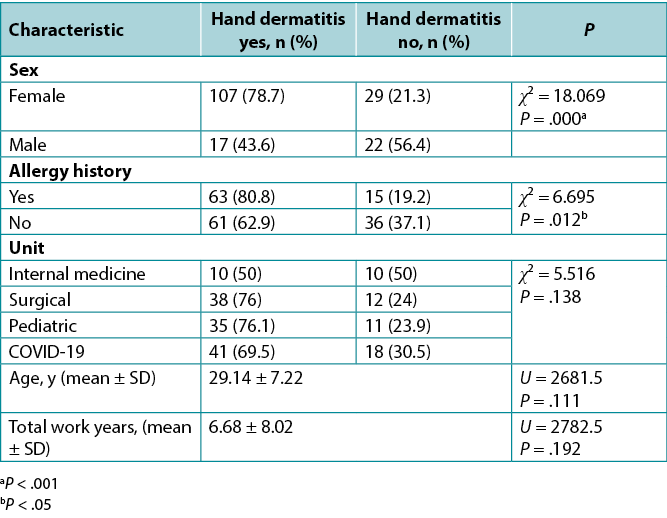
The most frequently reported symptoms were redness and fissures (sharply defined linear tears in the epidermis and dermis; 77.1%), irritation and itching (76%), and scaling/rash (67.4%; Figure 1).
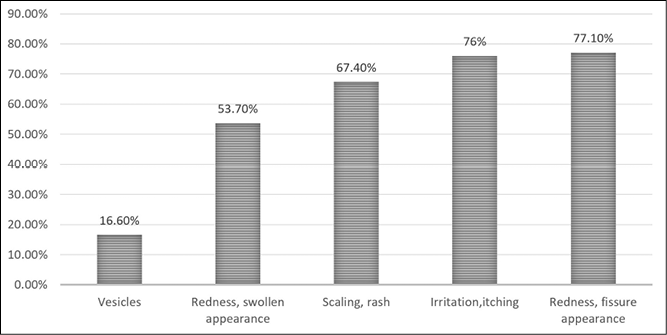
Figure 1. hand dermatitis symptoms
The frequency of hand dermatitis was 71.5% among nurses who provided care to patients who were COVID-19 positive, whereas the frequency of hand dermatitis was 66.7% among nurses who did not provide care to COVID-19 positive patients. This difference was not significant (Table 2).
Table 2. Frequency of hand dermatitis based on whether nurses cared for patients positive for COVID-19
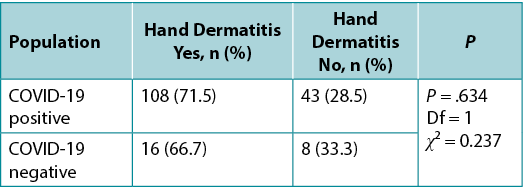
Nurses’ hand hygiene behaviours before and during the COVID-19 pandemic were examined (Table 3). It was determined that the frequency of handwashing per day, the use of disinfectants, and the use of hand cream/moisturiser had increased significantly during the pandemic (P < .001). In terms of handwashing frequency, 48% (84 of 175) of the nurses washed their hands more than 25 times a day. The frequency of hand dermatitis significantly increased with the frequency of handwashing (Table 4; P < .05). The frequency of hand disinfectant and hand cream use did not significantly affect hand dermatitis (P > .05). The most frequently used handwashing substances were liquid soap, liquid soap and alcohol-based gel, chlorhexidine-based gel, and alcohol-based gel (Figure 2).
Table 3. Hand hygiene behaviors of nurses before and during the pandemic

Table 4. Frequency of hand dermatitis by hygiene behavior
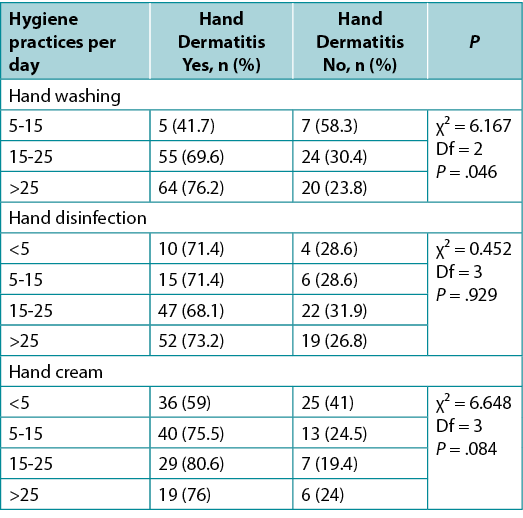
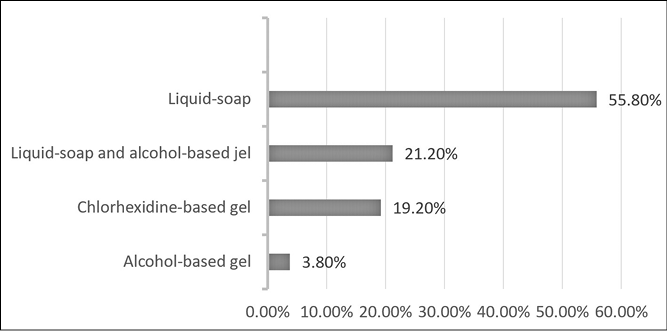
Figure 2. substances used by nurses for handwashing
Discussion
Hand dermatitis is a common disease that can progress either acutely or chronically and has different etiologies.15 In the current study, the frequency of hand dermatitis among nurses during the COVID-19 pandemic was 70.9%. The results of the current study were similar to those obtained in other studies conducted on hand dermatitis in health workers during the COVID-19 pandemic. One study conducted during the pandemic revealed that 84.6% of health workers had unwanted skin reactions on their hands.16 Another study reported that 74.5% of primary health workers had skin damage on their hands.10 A study conducted at the beginning of the pandemic found that 90.4% of health workers had acute symptoms of hand dermatitis.17
In a study conducted before the pandemic in the same region as the current study, 47.5% of the nurses working in pediatric clinics were reported to have hand dermatitis.11 The frequency of hand dermatitis was found to be 12%,18 21%,19,20 and 22.1%21 in other studies conducted before the pandemic. Given these results, it is clear that the frequency of hand dermatitis had increased among health workers during the pandemic.
In this study, the frequency of hand dermatitis was significantly higher in women than in men. Alluhayyan et al22 conducted a study with health workers and found that women were more prone to dermatitis. Likewise, Gupta et al23 found that hand dermatitis was slightly more common in women than in men. However, other studies have reported that sex did not have a significant effect on the frequency of hand dermatitis.12,21
Allergies are abnormal hypersensitivity reactions of the immune system against foreign substances.24,25 This response can be observed in early childhood as well as in adolescence and adulthood.25,26 The frequency of hand dermatitis was significantly higher among nurses who had a history of allergy compared with those without an allergy, which is consistent with previous studies.12,19,21,23 However, Kiely et al27 concluded that a history of allergy did not affect the development of dermatitis, despite reporting that the risk of developing dermatitis was significantly higher in health workers with a history of dermatitis.
One of the most common methods to prevent the spread of viruses is effective hand hygiene. In the fight against COVID-19 it is essential that effective hand hygiene habits are acquired in childhood.28 Kiely et al27 reported that the frequency of handwashing increased among almost all health workers (99.26%) during the pandemic. When the prepandemic and pandemic periods were compared in the current study, the frequency of handwashing and use of hand disinfectants/creams had increased significantly (Table 3). Similarly, Guertler et al17 conducted a study with physicians and nurses and found similar results. All of the guidelines for combating COVID-19 recommend thorough and frequent hand hygiene practices.2,5 Although the increase in the frequency of handwashing is one of the factors that contributes to the development of dermatitis, this should not dissuade health workers from appropriate hand hygiene practices during the pandemic.4
Nurses are the primary caregivers in a medical setting and are thus prone to infection with and transmission of the COVID-19 virus. It is vital that they comply with the guidelines for preventing and controlling infections to fight the pandemic.29
In another study conducted during the pandemic, Lan et al10 concluded that the frequency of hand dermatitis increased significantly in health workers who washed their hands more than 10 times a day. Studies conducted before the pandemic reported a significant relationship between an increased frequency of handwashing and the frequency of hand dermatitis.12,30 However, the present study found no significant difference in the frequency of hand dermatitis by use of hand cream. However, the hand creams used by nurses may not be ideal. The use of skin moisturisers is recommended to maintain healthy skin;31,32 for skin protection, humectants such as topical urea and propylene glycol and occlusive emollients such as petrolatum-based products, lanolin, mineral and vegetable oils, and waxes together are recommended. Concomitant use is beneficial to keep the stratum corneum moist and soothe the skin.33
Conclusions
This study found that the frequency of hand dermatitis among nurses during the pandemic was high. Sex, history of allergy, and increased frequency of handwashing were among the factors increasing hand dermatitis. Hand hygiene increased significantly among health workers during the pandemic. It was also found that nurses increased the measures they took to protect their skin to avoid dermatitis.
Hand disinfection plays an important strategic role in the fight against COVID-19. However, the skin and mucosa barrier are likely to be damaged in nurses who are consistently practicing good hygiene. Nurses should take proper measures to protect their skin while carrying out their duties.
Dermatite des mains chez les infirmières et infirmiers pendant la pandémie de COVID-19: fréquence et facteurs
Ayla İrem Aydın, Meryem Atak, Nurcan Özyazıcıoğlu Nurcan and Vahit Dalkızan
DOI: https://doi.org/10.33235/wcet.41.4.10-14
RÉSUMÉ
Objectif Déterminer la fréquence de la dermatite des mains chez les infirmières et infirmiers pendant la pandémie de COVID-19 et les facteurs affectant sa prévalence.
Méthodes L'échantillon de recherche était composé de 175 infirmières et infirmiers travaillant dans des hôpitaux publics. Les données de recherche ont été collectées via Google Survey entre octobre et septembre 2020. Les données ont été recueillies à l'aide d'un formulaire de collecte de données sociodémographiques, et un formulaire d'auto-évaluation a été utilisé pour déterminer les symptômes dermatologiques.
Résultats La fréquence de la dermatite des mains chez les infirmières et infirmiers était de 70,9%. Une différence statistiquement significative a été constatée selon le sexe, les antécédents allergiques, la fréquence accrue du lavage des mains et la fréquence de la dermatite des mains. Aucune différence significative en termes de fréquence de la dermatite des mains n'a été constatée entre les infirmières et infirmiers qui prodiguaient des soins à des patients positifs au COVID-19 et ceux qui n'ont pas prodigué de soins à des patients négatifs au COVID-19. Cependant, on a constaté que la fréquence du lavage des mains et de l'utilisation de désinfectants et ainsi que de crèmes pour les mains avait augmenté de manière significative pendant la pandémie de COVID-19 en regard de la période prépandémique.
Conclusions La fréquence de la dermatite des mains a augmenté chez les infirmières et infirmiers pendant la pandémie. La fréquence accrue du lavage des mains pendant la pandémie présente un risque de dermatite des mains chez les infirmières et infirmiers, bien que cela ne doive pas les décourager d'adopter une hygiène appropriée.
Introduction
L'Organisation mondiale de la santé (OMS) a déclaré que le COVID-19 était une pandémie mondiale. Selon les dernières données, environ 230 millions de personnes ont été infectées et 4,7 millions sont décédées.1 Des pratiques préventives non pharmacologiques telles que le maintien de la distance sociale, le port de masques faciaux et le lavage des mains ont été recommandées pour entraver la propagation du virus.2 Ces pratiques jouent un rôle important dans la réduction du risque de transmission en empêchant la propagation des aérosols et en protégeant les populations vulnérables. Des études suggèrent que l'hygiène des mains est une stratégie de prévention importante pour les professionnels de santé et la société dans les endroits où la pandémie est la plus répandue. L'hygiène des mains reste un élément essentiel de la lutte contre les infections.3-5
La pandémie de COVID-19 a également eu pour effet de rappeler aux infirmières et infirmiers la nécessité d'une hygiène régulière des mains avec du savon, de l'eau ou des désinfectants à base d'alcool. Le lavage des mains est recommandé comme une mesure préventive courante et peu coûteuse pour se protéger contre un certain nombre d'infections virales et empêcher la propagation des maladies en général.6
Une technique de lavage des mains appropriée fait partie d'une hygiène des mains efficace.5 Les CDC recommandent le lavage des mains au savon car il réduit la quantité de germes et de produits chimiques sur les mains.2 L'Organisation mondiale de la santé (OMS) recommande également le lavage des mains au savon pendant 40 à 60 secondes en utilisant une technique appropriée lorsque les mains sont visiblement souillées.7 Lorsque le savon et l'eau ne sont pas disponibles, un désinfectant pour les mains contenant au moins 60% d'alcool peut être utilisé.2 Si les mains ne sont pas visiblement souillées, il est préférable d'utiliser un désinfectant pour les mains à base d'alcool pendant 20 à 30 secondes avec la technique appropriée pour assurer l'hygiène des mains.7 Le lavage des mains avec une solution alcoolisée peut réduire le risque d'infection chez le personnel médical et les autres membres de la communauté en réduisant le nombre de bactéries et de virus sur les mains.2,8
Cependant, les solutions utilisées, la fréquence du lavage des mains, le niveau d'humidité et le processus de séchage des mains peuvent perturber la barrière cutanée et entraîner des symptômes de dermatite des mains.9-12 En conséquentce l'objectif de cette étude était de déterminer la fréquence de la dermatite des mains chez les infirmières et infirmiers pendant la pandémie de COVID-19 et les facteurs affectant son incidence.
Méthodes
Echantillon
La population étudiée était composée d'infirmières et infirmiers travaillant dans trois hôpitaux publics différents de Bursa (Turquie). L'échantillon de recherche se composait de 175 infirmières et infirmiers qui ont volontairement accepté de participer à l'étude.
Collecte des données
Les données de l'étude ont été collectées par les chercheurs entre septembre et octobre 2020 via Google Survey. Les outils de collecte des données comprenaient deux formulaires préparés par les chercheurs: un formulaire recueillait les informations sociodémographiques et l'autre évaluait les symptômes dermatologiques.
Formulaire de collecte de données sociodémographiques. Ce formulaire comprenait des questions sur le sexe, l'âge et le niveau de formation des infirmières et infirmiers ayant participé à l'étude, sur l'hôpital et le service dans lesquels ils travaillaient, ainsi que sur le nombre total d'années d'emploi.
Formulaire de détermination des symptômes dermatologiques. Ce formulaire comprenait des questions sur les antécédents allergiques, les traitements médicamenteux, le statut COVID-19 des patients de l'infirmière ou infirmier, la fréquence du lavage des mains et l'utilisation de désinfectants et de crèmes pour les mains. Dans la dernière partie du formulaire, les infirmières et infirmiers devaient auto-évaluer tout symptôme dermatologique spécifique à la dermatite des mains. Le formulaire a été traduit en turc par un chercheur et un anglophone. Les traductions ont été comparées, la terminologie la plus appropriée a été sélectionnée et la version finale a ensuite été retraduite en anglais. Le texte traduit a été comparé au formulaire original et révisé en conséquence. Les auteurs de l'étude avaient utilisé auparavant ce formulaire d'auto-évaluation avec des infirmières et infirmiers pédiatriques et des étudiants infirmiers.11,12 Le formulaire évalue conjointement les symptômes de dermatite de contact irritante ou allergique et a été conçu selon les critères de Smit et al.13,14 L’autorisation a été obtenue de Coenraads et al. pour l'utilisation de ce formulaire.13,14
Les questions portaient sur la présence de l'un des symptômes suivants au cours des 12 derniers mois:
- Desquamation et rougeur sur les mains et entre les doigts
- Fissures et rougeurs sur les mains
- Irritation ou démangeaisons des mains
- Gonflement et rougeur des mains
- Vésicules entre les mains et les doigts
Les participants qui ont répondu "oui" à une ou plusieurs de ces questions ont été diagnostiqués comme porteurs de symptômes de dermatite des mains.
Les questions suivantes ont également été posées:
- Deux ou plusieurs de ces symptômes ont-ils duré plus de 3 semaines ?
- Deux ou plusieurs de ces symptômes se sont-ils produits plus d'une fois ?
Les participants ayant répondu "oui" à l'une ou l'autre de ces questions ont été diagnostiqués comme souffrant de dermatite récurrente ou sévère des mains. Le coefficient α de Cronbach du formulaire était de 0,888.
Analyse des données
Des distributions numériques et en percentiles ont été utilisées pour les données sociodémographiques et le test U de Mann Whitney, le test de rang de signe de Wilcoxon et le test χ2 de Pearson ont été utilisés pour les comparaisons. Le SPSS pour Windows Version 23.0 a été utilisé pour l'analyse des données.
Considérations éthiques
L'approbation éthique de la recherche a été reçue du Comité d'éthique de la recherche et de la publication de l'Université des sciences de la santé de Bursa Uludağ (date et numéro de décision: 29.07.2020; 92662996-04). L'autorisation légale a été obtenue auprès des institutions de santé concernées. Le consentement des infirmières et infirmiers qui ont participé à l'étude a été obtenu via Google Survey.
Resultats
Le tableau 1 présente les caractéristiques personnelles des infirmières et infirmiers participant à l'étude. La fréquence de la dermatite des mains chez les infirmières et infirmiers était de 70,9% (124 sur 175). La fréquence de la dermatite des mains était significativement plus élevée chez les femmes que chez les hommes. La fréquence de la dermatite des mains était significativement plus élevée chez les infirmières et infirmiers qui avaient des antécédents allergiques que chez ceux qui n'en avaient pas (P < ,05). L'âge moyen des infirmières et infirmiers participant à l'étude était de 29,14 ± 7,22 ans, et le nombre moyen d'années d'emploi était de 6,68 ± 8,02. Aucune différence significative n'a été constatée dans la fréquence de la dermatite des mains chez les infirmières et infirmiers en fonction de l'âge moyen ou du nombre d’années d'emploi. Lorsque l'incidence de la dermatite des mains a été examinée en fonction du service où travaillaient les infirmières et infirmiers, la fréquence était plus élevée chez les infirmières et infirmiers travaillant dans les services de pédiatrie (76,1%), de chirurgie (76%) et de COVID-19 (69,5%). Cependant, aucune différence significative n'a été constatée par service (P > ,05).
Tableau 1. Caractéristiques des participants

Les symptômes les plus fréquemment signalés étaient la rougeur et les fissures (déchirures linéaires nettement définies dans l'épiderme et le derme; 77,1%), l'irritation et les démangeaisons (76%), et la desquamation/l'éruption (67,4% ; Figure 1).
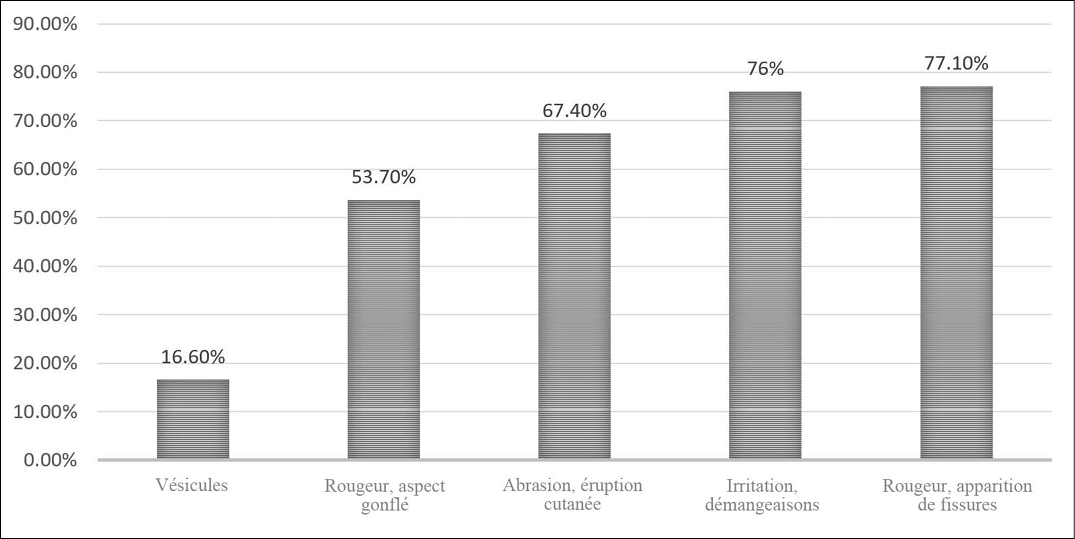
Figure 1. Symptômes de la dermatite des mains
La fréquence de la dermatite des mains était de 71,5% chez les infirmières et infirmiers ayant prodigué des soins à des patients positifs au COVID-19, tandis que la fréquence de la dermatite des mains était de 66,7% chez les infirmières et infirmiers n'ayant pas prodigué de soins à des patients positifs au COVID-19. Cette différence n'était pas significative (Tableau 2).
Tableau 2. Fréquence de la dermatite des mains selon que les infirmières et infirmiers se sont occupés ou non de patients positifs au COVID-19
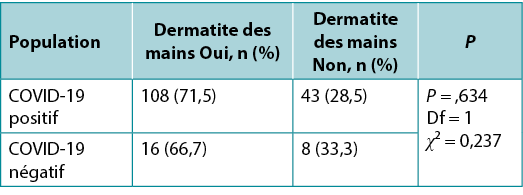
Les comportements des infirmières et infirmiers en matière d'hygiène des mains avant et pendant la pandémie de COVID-19 ont été examinés (Tableau 3). Il a été déterminé que la fréquence du lavage des mains par jour, l'utilisation de désinfectants et l'utilisation de crème/hydratant pour les mains avaient augmenté de manière significative pendant la pandémie (P < ,001). En ce qui concerne la fréquence du lavage des mains, 48% (84 sur 175) des infirmières et infirmiers se sont lavées les mains plus de 25 fois par jour. La fréquence de la dermatite des mains a significativement augmenté avec la fréquence du lavage des mains (Tableau 4 ; P < ,05). La fréquence d'utilisation des désinfectants et des crèmes pour les mains n'a pas eu d'effet significatif sur la dermatite des mains (P > ,05). Les substances de lavage des mains les plus fréquemment utilisées étaient le savon liquide, le savon liquide et le gel à base d'alcool, le gel à base de chlorhexidine et le gel à base d'alcool (Figure 2).
Tableau 3. Comportements d'hygiène des mains des infirmières/infirmiers avant et pendant la pandémie
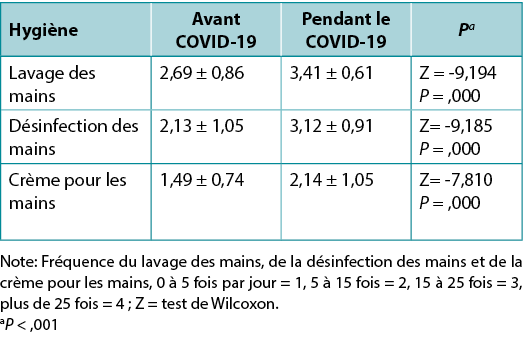
Tableau 4. Fréquence de la dermatite des mains en fonction du comportement d'hygiène
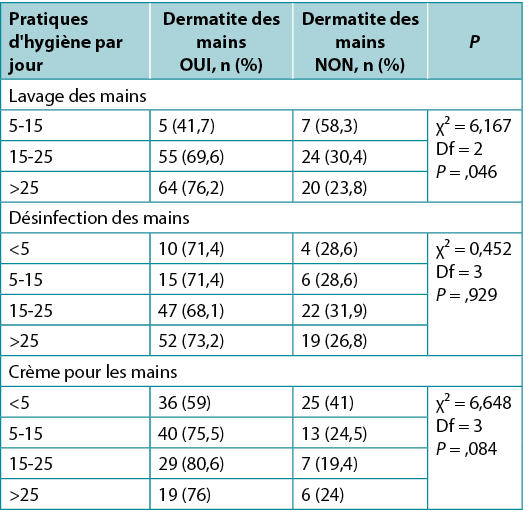
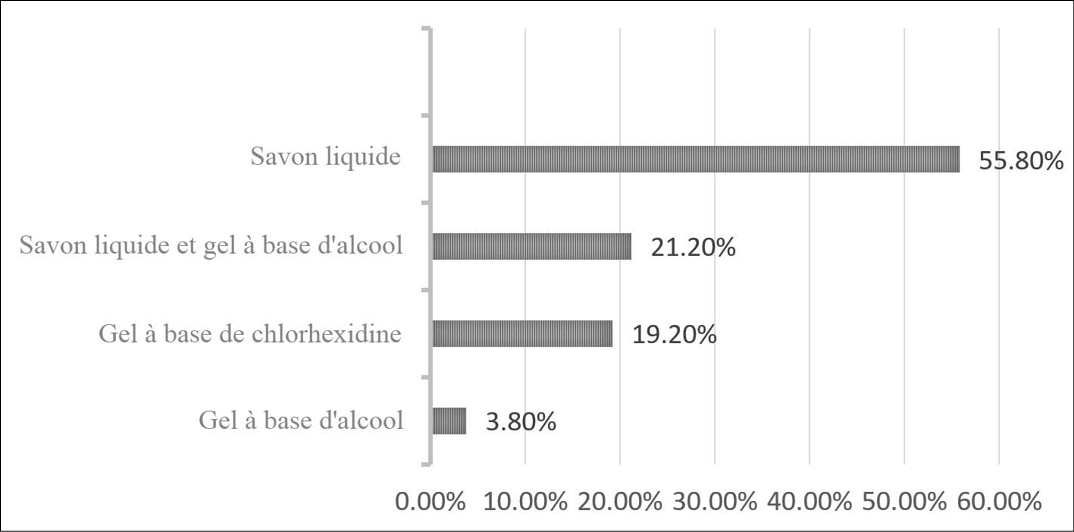
Figure 2. Substances utilisées par les infirmières/infirmiers pour le lavage des mains
Discussion
La dermatite des mains est une maladie courante qui peut évoluer de manière aiguë ou chronique et qui a différentes étiologies.15 Dans l'étude actuelle, la fréquence de la dermatite des mains chez les infirmières et infirmiers pendant la pandémie de COVID-19 était de 70,9%. Les résultats de l'étude actuelle sont similaires à ceux obtenus dans d'autres études menées sur la dermatite des mains chez les professionnels de santé pendant la pandémie de COVID-19. Une étude menée pendant la pandémie a révélé que 84,6% des professionnels de santé avaient des réactions cutanées indésirables sur les mains.16 Une autre étude a rapporté que 74,5% des professionnels de santé en première ligne avaient des lésions cutanées sur les mains.10 Une étude menée au début de la pandémie a révélé que 90,4% des professionnels de santé avaient des symptômes aigus de dermatite des mains.17
Dans une étude menée avant la pandémie dans la même région que l'étude actuelle, 47,5% des infirmières travaillant dans des services pédiatriques souffraient de dermatite des mains.11 La fréquence de la dermatite des mains était de 12%,18 21%,19,20 et 22,1%21 dans d'autres études menées avant la pandémie. Au vu de ces résultats, il est clair que la fréquence de la dermatite des mains a augmenté chez les professionnels de santé pendant la pandémie.
Dans cette étude, la fréquence de la dermatite des mains était significativement plus élevée chez les femmes que chez les hommes. Alluhayyan et al.22 ont mené une étude auprès de professionnels de santé et ont constaté que les femmes étaient plus sujettes à la dermatite. De même, Gupta et al.23 ont constaté que la dermatite des mains était légèrement plus fréquente chez les femmes que chez les hommes. Cependant, d'autres études ont rapporté que le sexe n'avait pas d'effet significatif sur la fréquence de la dermatite des mains.12,21
Les allergies sont des réactions d'hypersensibilité anormales du système immunitaire contre des substances étrangères.24,25 Cette réaction peut être observée dans la petite enfance ainsi qu'à l'adolescence et à l'âge adulte.25,26 La fréquence de la dermatite des mains était significativement plus élevée chez les infirmières et infirmiers qui avaient des antécédents allergiques que chez ceux qui n'en avaient pas, ce qui est conforme aux études précédentes.12,19,21,23 Cependant, Kiely et al.27 ont conclu que des antécédents allergiques n'avaient pas d'incidence sur le développement de la dermatite, bien qu'ils aient signalé que le risque de développer une dermatite était significativement plus élevé chez les professionnels de santé ayant des antécédents de dermatite.
L'une des méthodes les plus courantes pour prévenir la propagation des virus est une hygiène des mains efficace. Dans la lutte contre le COVID-19, il est essentiel que des habitudes efficaces d'hygiène des mains soient acquises dès l'enfance.28 Kiely et al.27 ont signalé que la fréquence du lavage des mains a augmenté chez presque tous les professionnels de santé (99,26%) pendant la pandémie. Lorsque les périodes prépandémique et pandémique ont été comparées dans l'étude actuelle, la fréquence du lavage des mains et l'utilisation de crèmes/désinfectants pour les mains avaient augmenté de manière significative (tableau 3). De même, Guertler et al.17 ont mené une étude auprès de médecins et d'infirmières et infirmiers et ont obtenu des résultats similaires. Toutes les directives de lutte contre le COVID-19 recommandent des pratiques d'hygiène des mains complètes et fréquentes.2,5 Bien que l'augmentation de la fréquence du lavage des mains soit l'un des facteurs qui contribuent au développement de la dermatite, cela ne doit pas dissuader les professionnels de santé d'adopter des pratiques d'hygiène des mains appropriées pendant la pandémie.4
Les infirmières et infirmiers sont les principaux soignants dans un environnement médical et sont donc susceptibles d'être infectées par le virus COVID-19 et de le transmettre. Il est essentiel qu'ils se conforment aux directives de prévention et de contrôle des infections pour lutter contre la pandémie.29
Dans une autre étude menée pendant la pandémie, Lan et al.10 ont conclu que la fréquence de la dermatite des mains augmentait de manière significative chez les professionnels de santé qui se lavaient les mains plus de 10 fois par jour. Des études menées avant la pandémie ont rapporté une relation significative entre une fréquence accrue du lavage des mains et la fréquence de la dermatite des mains.12,30 Cependant, la présente étude n'a trouvé aucune différence significative dans la fréquence de la dermatite des mains en fonction de l'utilisation de crème pour les mains. Cependant, les crèmes pour les mains utilisées par les infirmières et infirmiers ne sont pas forcément idéales. L'utilisation d'hydratants cutanés est recommandée pour maintenir une peau saine;31,32 pour la protection de la peau, il est recommandé d'utiliser des humectants comme l'urée topique et le propylène glycol et des émollients occlusifs comme les produits à base de pétrolatum, la lanoline, les huiles minérales et végétales et les cires. Une utilisation concomitante est bénéfique pour maintenir la couche cornée humide et apaiser la peau.33
Conclusions
Cette étude a révélé que la fréquence de la dermatite des mains chez les infirmières et infirmiers pendant la pandémie était élevée. Le sexe, les antécédents allergiques et la fréquence accrue du lavage des mains figuraient parmi les facteurs d'augmentation de la dermatite des mains. L'hygiène des mains a augmenté de manière significative parmi les professionnels de santé pendant la pandémie. Il a également été constaté que les infirmières et infirmiers prenaient davantage de mesures pour protéger leur peau afin d'éviter les dermatites.
La désinfection des mains joue un rôle stratégique important dans la lutte contre le COVID-19. Toutefois, la barrière cutanée et muqueuse est susceptible d'être endommagée chez les infirmières et infirmiers qui pratiquent systématiquement une bonne hygiène. Les infirmières et infirmiers doivent prendre des mesures appropriées pour protéger leur peau dans l'exercice de leurs fonctions.
Author(s)
Ayla İrem Aydın*
MSc, RN
Research Assistant, Department of Pediatric Nursing, Faculty of Health Sciences, Bursa Uludağ University, Turkey
Meryem Atak
MSc, RN
Research Assistant, Department of Pediatric Nursing, Faculty of Health Sciences, Bursa Uludağ University, Turkey
Nurcan Özyazıcıoğlu Nurcan
PhD, RN
Professor, Dean of Faculty of Health Sciences
Department of Pediatric Nursing, Faculty of Health Sciences, Bursa Uludağ University, Turkey
Vahit Dalkızan
RN
Nurse in the ICU, Ministry of Health Bursa City Hospital, Turkey
* Corresponding author
References
- World Health Organization. Coronavirus disease (COVID-19) pandemic. 2021. www.who.int/emergencies/diseases/novel-coronavirus-2019. Last accessed September 27, 2021.
- Centers for Disease Control & Prevention. Coronavirus Disease 2019 (COVID-19). June 2021. www.cdc.gov/coronavirus/2019-ncov/prevent-getting-sick/hand-sanitizer.html. Last accessed June 25, 2021.
- Aiello AE, Perez V, Coulborn RM, Davis BM, Uddin M, Monto AS. Facemasks, hand hygiene, and influenza among young adults: a randomized intervention trial. PloS One 2012;7:e29744.
- Sibbald RG, Ayello EA. Hand dermatitis, hand hygiene, and healthcare professionals. Adv Skin Wound Care 2020;33:175.
- World Health Organization. WHO save lives: Clean your hands. May 2020. www.who.int/docs/default-source/infection-prevention-and-control/clean-hands-2020/advocacy-slides-2020-long-version.pdf. Last accessed October 1, 2021.
- Townsend J, Greenland K, Curtis V. Costs of diarrhoea and acute respiratory infection attributable to not handwashing: the cases of India and China. Trop Med Int Health 2017;22:74-81.
- World Health Organization. Coronavirus disease (COVID-19) advice for the public. June 2021. www.who.int/emergencies/diseases/novel-coronavirus-2019/advice-for-public. Last accessed June 25, 2021.
- Maliyar K, Sibbald C, Pope E, Gary Sibbald R. Diagnosis and management of atopic dermatitis: a review. Adv Skin Wound Care 2018;31:538–50.
- Al Badri FM. Surgical mask contact dermatitis and epidemiology of contact dermatitis in healthcare workers. Curr Allergy Clin Immunol 2017;30:183-8.
- Lan J, Song Z, Miao X, et al. Skin damage among health care workers managing coronavirus disease-2019. J Am Acad Dermatol 2020;82:1215-6.
- Özyazıcıoğlu N, Sürenler S, Tanrıverdi G. Hand dermatitis among paediatric nurses. J Clin Nurs 2010;19:1597-603.
- Özyazicioglu N, Sürenler S, Aydin AI, Atak M. Hand dermatitis in nursing students. Adv Skin Wound Care 2020;33:213-6.
- Smit HA, Coenraads PJ, Lavrijsen PM, Nater JP. Evaluation of a self-administered questionnaire on hand dermatitis. Contact Dermatitis 1992;26:11–6.
- Smit HA, Burdorf A, Coenraads PJ. Prevalence of hand dermatitis in different occupations. Int J Epidemiol 1993;22:288–93.
- Alavi A, Skotnicki S, Sussman G, Sibbald RG. Diagnosis and treatment of hand dermatitis. Adv Skin Wound Care 2012;25:371-80.
- Lin P, Zhu S, Huang Y, et al. Adverse skin reactions among healthcare workers during the coronavirus disease 2019 outbreak: a survey in Wuhan and its surrounding regions. Br J Dermatol 2020;183:190-2.
- Guertler A, Moellhoff N, Schenck TL, et al. Onset of occupational hand eczema among healthcare workers during the SARS-CoV-2 pandemic: Comparing a single surgical site with a COVID-19 intensive care unit. Contact Dermatitis 2020;83:108-14.
- van der Meer EW, Boot CR, van der Gulden JW, Jungbauer FH, Coenraads PJ, Anema JR. Hand eczema among healthcare professionals in the Netherlands: prevalence, absenteeism, and presenteeism. Contact Dermatitis 2013;69:164-71.
- Ibler KS, Jemec GB, Flyvholm MA, Diepgen TL, Jensen A, Agner T. Hand eczema: prevalence and risk factors of hand eczema in a population of 2274 healthcare workers. Contact Dermatitis 2012;67:200-7.
- Hamnerius N, Svedman C, Bergendorff O, Björk J, Bruze M, Pontén A. Wet work exposure and hand eczema among healthcare workers: a cross-sectional study. Br J Dermatol 2018;178:452-61.
- Luk NM, Lee HC, Luk CK, et al. Hand eczema among Hong Kong nurses: a self-report questionnaire survey conducted in a regional hospital. Contact Dermatitis 2011;65:329-35.
- Alluhayyan OB, Alshahri BK, Farhat AM, et al. Occupational-related contact dermatitis: prevalence and risk factors among healthcare workers in the Al’Qassim Region, Saudi Arabia during the COVID-19 pandemic. Cureus 2020;12:e10975.
- Gupta SB, Gupta A, Shah B, et al. Hand eczema in nurses, nursing auxiliaries and cleaners- a cross-sectional study from a tertiary hospital in western India. Contact Dermatitis 2018;79:20-5.
- American Academy of Allergy, Asthma & Immunology. Allergies. 2021. www.aaaai.org/conditions-and-treatments/allergies. Last accessed June 25, 2021.
- Hopp RJ. Hypersensitivity reactions: an everyday occurrence in pediatric allergy clinics. Pediatr Allergy Immunol Pulmonol 2020;33:12-8.
- Czarnowicki T, He H, Krueger JG, Guttman-Yassky E. Atopic dermatitis endotypes and implications for targeted therapeutics. J Allergy Clin Immunol 2019;143:1–11.
- Kiely LF, Moloney E, O’Sullivan G, Eustace JA, Gallagher J, Bourke JF. Irritant contact dermatitis in healthcare workers as a result of the COVID-19 pandemic: a cross-sectional study. Clin Exp Dermatol 2021;46(1):142-4.
- Borch L, Thorsteinsson K, Warner TC, et al. COVID-19 reopening causes high risk of irritant contact dermatitis in children. Dan Med J 2020;67:A05200357.
- Lotfinejad N, Peters A, Pittet D. Hand hygiene and the novel coronavirus pandemic: the role of healthcare workers. J Hosp Infect 2020;105:776-7.
- Zhang D, Zhang J, Sun S, Gao M, Tong A. Prevalence and risk factors of hand eczema in hospital-based nurses in northern China. Australas J Dermatol 2018;59:e194-7.
- Yan Y, Chen H, Chen L, et al. Consensus of Chinese experts on protection of skin and mucous membrane barrier for health-care workers fighting against coronavirus disease 2019. Dermatol Ther 2020;33:e13310.
- Gupta MK, Lipner SR. Hand hygiene in preventing COVID-19 transmission. Cutis 2020;105:233-4.
- Beiu C, Mihai M, Popa L, Cima L, Popescu MN. Frequent hand washing for COVID-19 prevention can cause hand dermatitis: management tips. Cureus 2020;12:e7506.
